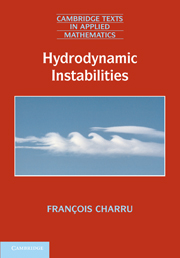Book contents
- Frontmatter
- Contents
- Foreword
- Preface
- Video resources
- 1 Introduction
- 2 Instabilities of fluids at rest
- 3 Stability of open flows: basic ideas
- 4 Inviscid instability of parallel flows
- 5 Viscous instability of parallel flows
- 6 Instabilities at low Reynolds number
- 7 Avalanches, ripples, and dunes
- 8 Nonlinear dynamics of systems with few degrees of freedom
- 9 Nonlinear dispersive waves
- 10 Nonlinear dynamics of dissipative systems
- 11 Dynamical systems and bifurcations
- Appendix A The Saint-Venant equations
- References
- Index
11 - Dynamical systems and bifurcations
Published online by Cambridge University Press: 05 August 2011
- Frontmatter
- Contents
- Foreword
- Preface
- Video resources
- 1 Introduction
- 2 Instabilities of fluids at rest
- 3 Stability of open flows: basic ideas
- 4 Inviscid instability of parallel flows
- 5 Viscous instability of parallel flows
- 6 Instabilities at low Reynolds number
- 7 Avalanches, ripples, and dunes
- 8 Nonlinear dynamics of systems with few degrees of freedom
- 9 Nonlinear dispersive waves
- 10 Nonlinear dynamics of dissipative systems
- 11 Dynamical systems and bifurcations
- Appendix A The Saint-Venant equations
- References
- Index
Summary
Introduction
A useful mathematical framework for studying linear and nonlinear stability is the theory of ordinary differential equations (ODEs), also known as the theory of dynamical systems when the focus is on geometric and qualitative representations of the ideas and solutions. An informal presentation of this theory was given in Chapter 1. The goal of this chapter is to give a more systematic account of it from a mathematical point of view. In particular, we shall show how to reduce the number of degrees of freedom of a problem to obtain the “normal forms” of elementary bifurcations referred to often in the previous chapters.
In spite of its restrictive nature relative to the theory of partial differential equations, the theory of dynamical systems has revealed the extraordinary richness and complexity of the types of behavior that can arise when nonlinear effects play a role. This theory originated in the work of Henri Poincaré, in particular, in his book Méthodes nouvelles de la mécanique céleste. Poincaré's ideas were further developed during the first half of the twentieth century by the Russian school of mathematics (Kolmogorov, Arnold). The discovery that a system with a small number of degrees of freedom can display unpredictable, chaotic behavior then led to a great deal of research in this area beginning in the 1960s. Qualitatively new concepts such as deterministic chaos and sensitivity to the initial conditions were introduced, and these have significantly modified our understanding of deterministic models and their use in the description of natural phenomena.
Information
- Type
- Chapter
- Information
- Hydrodynamic Instabilities , pp. 326 - 368Publisher: Cambridge University PressPrint publication year: 2011
